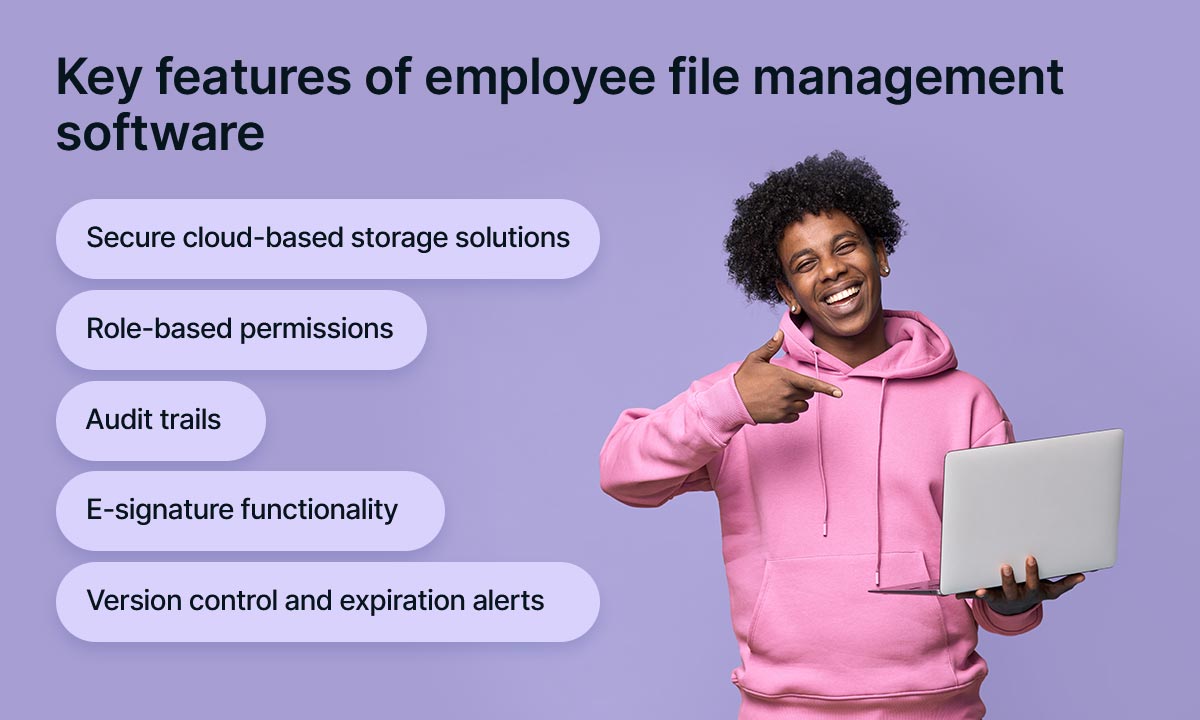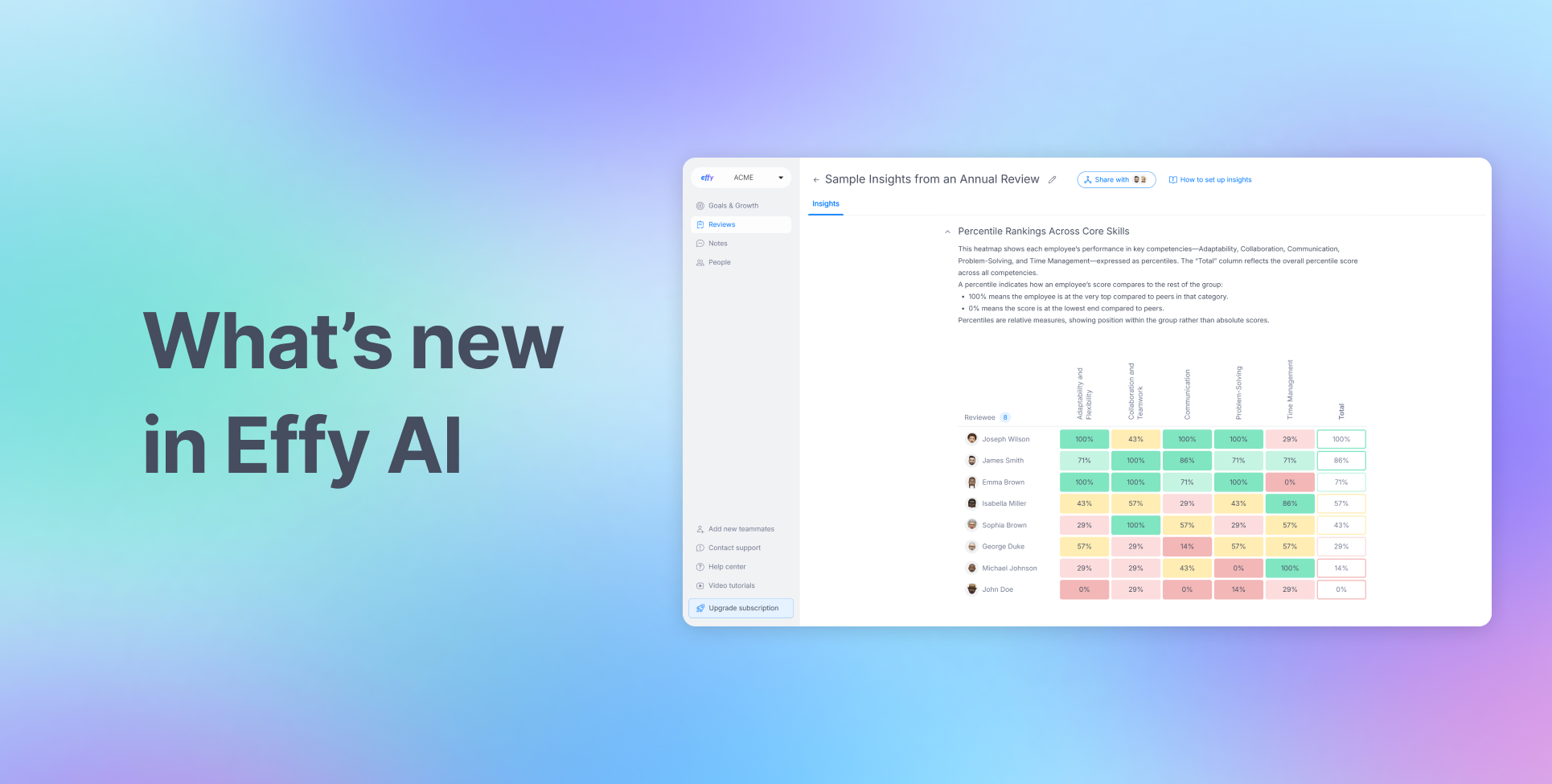Picture this: it's Monday morning and your CEO needs an employee's contract for an urgent legal review. You spend the next hour digging through filing cabinets, shared drives and email attachments, only to realize the document might be on someone else's computer.
This scenario plays out in HR departments everywhere, costing valuable time and creating unnecessary stress. Modern employee file management software eliminates these frustrations by centralizing all employee documents in secure, searchable digital systems that work as hard as you do.
The right platform transforms chaotic paperwork into organized, compliant and accessible employee records. Whether you're managing five workers or five thousand, investing in proper employee database software is about operational efficiency, legal compliance and peace of mind.
{{banner-7="/banner-page"}}
What is employee file management software?
Think of employee file management software as your digital filing cabinet but way smarter. Instead of drowning in paperwork and losing important documents, you get a centralized employee documentation system that keeps everything organized, secure and easily accessible whenever you need it.
These platforms are specifically designed for HR needs, with features like role-based access controls, audit trails and automated compliance tracking. They understand that personnel files contain sensitive information requiring special handling.
The best part? Many solutions integrate seamlessly with your existing HR tools, including performance review software, creating a unified ecosystem where all employee data flows together naturally. No more jumping between different platforms or losing track of important documents.
Why your HR team needs employee document management software
Let’s get on the same page. Managing employee records manually is a nightmare. Between compliance requirements, security concerns and the sheer volume of documents, your HR team probably spends way too much time hunting for paperwork instead of focusing on strategic initiatives.
Streamlined document access and retrieval
You know the drill: someone needs an employee's contract ASAP and you're digging through folders, emails and shared drives. Digital document management software puts everything in one searchable location so you can find what you need in seconds, not hours.
Automated compliance and audit readiness
Employment laws are complicated and penalties for non-compliance can be brutal. Modern employee record management software automatically tracks retention schedules, sends renewal reminders and maintains audit trails. Basically doing the compliance heavy lifting for you.
Enhanced data security and access controls
Employee documents contain everything from social security numbers to salary details. You need security that's bulletproof but doesn't make accessing files a bureaucratic nightmare. The right system gives authorized users quick access while keeping sensitive data locked down.
Scalable infrastructure for growing organizations
Growing your team shouldn't mean drowning in documents. These systems handle increased volume effortlessly, integrating with tools like 360 feedback software to automatically organize performance data as your workforce expands, keeping everything structured and accessible.
5 best HR employee file management software
Choosing the right platform can transform your HR operations from chaotic to streamlined. We've evaluated dozens of solutions to identify the best HR document management software options that deliver real value for different organizational needs and budgets.
BambooHR
BambooHR offers comprehensive employee file management within its all-in-one HR platform, providing intuitive document storage, e-signature capabilities and automated workflows. The system excels at organizing relevant documents while maintaining user-friendly navigation for HR teams of all experience levels.
Pros:
- Intuitive interface requires minimal training for HR staff adoption
- Strong integration ecosystem with payroll, benefits and recruiting tools
- Excellent customer support with dedicated implementation assistance
Cons:
- Higher pricing compared to standalone document management solutions
- Limited customization options for unique organizational workflows
- Advanced reporting features require higher-tier plans
Best suited for: Small to medium businesses seeking comprehensive HR functionality
Workday HCM
Workday delivers enterprise-grade personnel file management software with robust security features, advanced analytics and seamless integration with performance management tools. The platform handles complex organizational structures while maintaining compliance across multiple jurisdictions and regulatory requirements.
Pros:
- Enterprise-level security and compliance capabilities for large organizations
- Advanced analytics and reporting for strategic HR decision-making
- Highly scalable architecture supports rapid corporate growth
Cons:
- Complex implementation process requiring significant time and resources
- Steep learning curve for users unfamiliar with enterprise software
- Premium pricing may be prohibitive for smaller organizations
Best suited for: Large enterprises with complex HR requirements
Zenefits
Zenefits combines document management software with essential HR functions, offering cloud-based storage, automated compliance tracking and streamlined onboarding processes. The platform focuses on simplicity while providing the core features most organizations need for effective employee record management.
Pros:
- Affordable pricing structure suitable for budget-conscious organizations
- Quick setup and implementation with minimal technical requirements
- Integrated benefits administration and payroll processing capabilities
Cons:
- Limited advanced features compared to enterprise-focused solutions
- Basic reporting and analytics functionality may not meet complex needs
- Customer support quality can be inconsistent during peak periods
Best suited for: Small businesses with limited HR staff and tight budgets
Gusto
Gusto provides centralized document storage alongside payroll and benefits administration, making it an ideal choice for companies seeking integrated HR functionality. The platform emphasizes user experience while maintaining the security and compliance features essential for employee file management.
Pros:
- Excellent user experience with clean, intuitive interface design
- Strong payroll integration eliminates duplicate data entry requirements
- Competitive pricing with transparent fee structure and no hidden costs
Cons:
- Limited advanced HR features compared to specialized platforms
- Basic document organization may not suit complex filing requirements
- Integration options are somewhat limited compared to larger platforms
Best suited for: Growing businesses prioritizing ease of use and payroll integration
PeopleKeep
PeopleKeep specializes in benefits administration while offering solid document management capabilities for health insurance and compliance documentation. The platform serves organizations looking for focused solutions rather than comprehensive HR suites.
Pros:
- Specialized expertise in benefits administration and health insurance compliance
- Cost-effective solution for organizations with succession planning template
- Simple setup process with minimal ongoing maintenance requirements
Cons:
- Limited scope compared to full-featured HR document management platforms
- Fewer integration options with other HR and business systems
- Basic user interface may lack advanced organizational features
Best suited for: Organizations focused primarily on benefits administration and compliance
Key features to look for in HR file management solutions
Not all employee file management software is created equal. The right platform should offer specific capabilities that address your unique HR challenges while providing room for growth. Here are the essential features that separate basic storage from comprehensive HR solutions.

Role-based access controls and permissions
Security starts with controlling who can access what information. Look for systems that allow you to set segmented access rules based on roles, departments or specific document types. This ensures sensitive information stays protected while maintaining operational efficiency.
Automated compliance and retention management
Employment laws require specific retention periods for different document types. A quality employee documents solution automatically tracks these requirements, sends renewal alerts and maintains audit trails. This feature alone can save you from costly compliance violations.
Integration capabilities with existing HR systems
Your file management system shouldn't exist in isolation. The best platforms integrate seamlessly with payroll, benefits, recruiting and employee feedback software, creating a unified ecosystem where data flows naturally between applications without manual intervention.
Advanced search and document organization
When you need a document quickly, sophisticated search functionality becomes invaluable. Look for systems that offer metadata tagging, full-text search and logical folder structures that mirror your organizational hierarchy and HR processes.
Mobile accessibility and remote work support
Today's workforce demands flexibility and your document management system should deliver accordingly. Cloud-based solutions with mobile apps ensure authorized users can access critical documents whether they're in the office, working from home or traveling.
How to implement employee file management software
Selecting the best HR document management software is only half the battle. Successful implementation requires careful planning and execution. A strategic approach ensures smooth adoption, minimizes disruption and maximizes the return on your technology investment from day one.
Plan your data migration strategy carefully
Moving existing employee files into a new system requires methodical planning to avoid data loss or organizational chaos. Take time to clean up outdated documents, establish naming conventions and create a logical folder structure before migration begins.
- Audit existing files and purge outdated or duplicate documents before transfer
- Establish consistent naming conventions and folder structures across all departments
- Create a detailed migration timeline with backup procedures and rollback plans
Provide comprehensive training and change management
Even the most intuitive systems require proper training to ensure widespread adoption. Focus on demonstrating practical benefits rather than just technical features and address concerns proactively to build confidence and enthusiasm among your team.
- Conduct role-specific training sessions that highlight relevant features for each user group
- Create quick reference guides and video tutorials for ongoing support and troubleshooting
- Designate internal champions who can provide peer-to-peer assistance during the transition period
Integrate with existing HR workflows and systems
The most successful implementations connect seamlessly with existing processes and tools, including employee development software and other HR platforms. This integration approach minimizes disruption while maximizing the value of your existing technology investments.
- Map current workflows to identify integration points with payroll, benefits and recruiting systems
- Test all integrations thoroughly before full deployment to ensure data flows correctly
- Establish regular system maintenance schedules and update procedures for long-term success
Summing up
Implementing employee file management software is about transforming how your HR team operates. The right system eliminates time-wasting document searches, ensures compliance and creates a foundation for scalable HR operations.
The platforms we've discussed offer different strengths depending on your organization's size, budget and specific needs. Whether you choose a comprehensive solution like BambooHR or a focused tool like PeopleKeep, the key is selecting software that grows with your organization.
Your HR team deserves tools that make their jobs easier, not harder. By investing in quality document management, you're not just organizing files—you're empowering your team to focus on what matters most: building great workplace experiences for your people.
{{banner-7="/banner-page"}}


